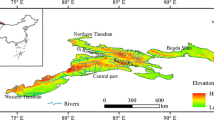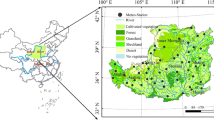Abstract
The Qinling Mountains, located at the junction of warm temperate and subtropical zones, serve as the boundary between north and south China. Exploring the sensitivity of the response of vegetation there to hydrothermal dynamics elucidates the dynamics and mechanisms of the main vegetation types in the context of changes in temperature and moisture. Importance should be attached to changes in vegetation in different climate zones. To reveal the sensitivity and areal differentiation of vegetation responses to hydrothermal dynamics, the spatio-temporal variation characteristics of the normalized vegetation index (NDVI) and the standardized precipitation evapotranspiration index (SPEI) on the northern and southern slopes of the Qinling Mountains from 2000 to 2018 are explored using the meteorological data of 32 meteorological stations and the MODIS NDVI datasets. The results show that: 1) The overall vegetation coverage of the Qinling Mountains improved significantly from 2000 to 2018. The NDVI rise rate and area ratio on the southern slope were higher than those on the northern slope, and the vegetation on the southern slope improved more than that on the northern slope. The Qinling Mountains showed an insignificant humidification trend. The humidification rate and humidification area of the northern slope were greater than those on the southern slope. 2) Vegetation on the northern slope of the Qinling Mountains was more sensitive to hydrothermal dynamics than that on the southern slope. Vegetation was most sensitive to hydrothermal dynamics from March to June on the northern slope, and from March to May (spring) on the southern slope. The vegetation on the northern and southern slopes was mainly affected by hydrothermal dynamics on a scale of 3–7 months, responding weakly to responding weakly to hydrothermal dynamics on a scale of 11–12 months. 3) Some 90.34% of NDVI and SPEI was positively correlated in the Qinling Mountains. Spring humidification in most parts of the study area promoted the growth of vegetation all the year round. The sensitivity of vegetation responses to hydrothermal dynamics with increasing altitude increased first and then decreased. Elevations of 800 to 1200 m were the most sensitive range for vegetation response to hydrothermal dynamics. The sensitivity of the vegetation response at elevations of 1200–3000 m decreased with increasing altitude. As regards to vegetation type, grass was most sensitive to hydrothermal dynamics on both the northern and southern slopes of the Qinling Mountains; but most other vegetation types on the northern slope were more sensitive to hydrothermal dynamics than those on the southern slope.
Similar content being viewed by others
References
Bai H Y, Liu K, Wang J et al., 2019. Vegetation Response and Adaptation in the Qinling Mountains under Climate Change Background. Beijing: Science Press, 16–18. (in Chinese)
Bai H Y, Ma X P, Gao X et al., 2012. Variations in January temperature and 0°C isothermal curve in Qinling Mountains based on DEM. Acta Geographica Sinica, 67(11): 1443–1450. (in Chinese)
Byakatonda J, Parida B P, Moalafhi D B et al., 2018. Analysis of long term drought severity characteristics and trends across semiarid Botswana using two drought indices. Atmospheric Research, 213: 492–508.
Chen C N, Zhu L Q, Tian L et al., 2019. Spatial-temporal changes in vegetation characteristics and climate in the Qinling-Daba Mountains. Acta Ecologica Sinica, 39(9): 3257–3266. (in Chinese)
Chen L, Li S H, Hou L et al., 2017. Response of Larix chinensis radial growth to climatic factors based on the Vaganov-Shashkin model. Chinese Journal of Applied Ecology, 28(8): 2470–2480. (in Chinese)
Dai A G, 2012. Increasing drought under global warming in observations and models. Nature Climate Change, 3: 52.
Deng C H, Bai H Y, Gao S et al., 2018a. Comprehensive effect of climatic factors on plant phenology in Qinling Mountains region during 1964–2015. Acta Geographica Sinica, 73(5): 917–931. (in Chinese)
Deng C H, Bai H Y, Gao S et al., 2018b. Spatial-temporal variation of the vegetation coverage in Qinling Mountains and its dual response to climate change and human activities. Journal of Natural Resources, 33(3): 425–438. (in Chinese)
Dong J W, Liu J Y, Zhang G L et al., 2013. Climate change affecting temperature and aridity zones: A case study in Eastern Inner Mongolia, China from 1960–2008. Theoretical and Applied Climatology, 113(3): 561–572.
Fu B J, Yu D D, Lü N, 2017. An indicator system for biodiversity and ecosystem services evaluation in China. Acta Ecologica Sinica, 37(2): 341–348. (in Chinese)
Gao J B, Jiao K W, Wu S H, 2019. Revealing the climatic impacts on spatial heterogeneity of NDVI in China during 1982–2013. Acta Geographica Sinica, 74(3): 534–543. (in Chinese)
Hou L, Li S H, Chen L et al., 2017. Reconstruction of the historical temperature from February to April of the Qinling Mountains in recent 200 years. Geographical Research, 36(8): 1428–1442. (in Chinese)
Hou M T, Zhao H Y, Wang Z et al., 2013. Vegetation responses to climate change by using the satellite-derived normalized difference vegetation index: A review. Climatic and Environmental Research, 18(3): 353–364. (in Chinese)
Huang J P, Ji M X, Xie Y K et al., 2016. Global semi-arid climate change over last 60 years. Climate Dynamics, 46(3/4): 1131–1150.
Hutchinson M F, Xu T, 2013. Anusplin Version 4.4 User Guide.
Kang M Y, Zhu Y, 2007. Discussion and analysis on the geo-ecological boundary in Qinling Range. Acta Ecologica Sinica, 27(7): 2774–2784. (in Chinese)
Kong D D, Zhang Q, Gu X H et al., 2016. Vegetation responses to drought at different timescales in China. Acta Ecologica Sinica, 36(24): 7908–7918. (in Chinese)
Li Y J, Ding J L, Zhang J Y et al., 2019. Response of vegetation cover to drought in the northern slope of the Tianshan Mountains during 2001–2015 based on the land-use and land-cover change. Acta Ecologica Sinica, 39(17): 6206–6217. (in Chinese)
Liu S L, Tian Y Y, Yin Y J et al., 2016. Temporal dynamics of vegetation NDVI and its response to drought conditions in Yunnan province. Acta Ecologica Sinica, 36(15): 4699–4707. (in Chinese)
Liu Z H, Tim R M, Van Niel T G et al., 2008. Introduction of the professional interpolation software for meteorology data: ANUSPLIN. Meteorological Monthly, 34(2): 92–100. (in Chinese)
Lu F Z, Lu H Y, 2019. A high-resolution grid dataset of air temperature and precipitation for Qinling-Daba Mountains in central China and its implications for regional climate. Acta Geographica Sinica, 74(5): 875–888. (in Chinese)
Mckee T B, Doesken N J, Kleist J, 1993. The relationship of drought frequency and duration of timescales. Eighth Conference on Applied Climatology, American Meteorological Society: Anaheim, California, 174–184.
Meng Q, Bai H Y, Guo S Z, 2020. Spatial-temporal variation of precipitation in Qinling area in recent 50 years based on Anusplin. Research of Soil and Water Conservation, 27(2): 206–212. (in Chinese)
Palmer W C, 1968. Keeping track of crop moisture conditions, nationwide: the new crop moisture index. Weatherwise, 21(4): 156–161.
Qi G Z, Bai H Y, Meng Q et al., 2019. Climate change in the Qinling Mountains in spring during 1959–2018. Arid Zone Research, 36(5): 1079–1091. (in Chinese)
Qin J, Bai H Y, Liu R J et al., 2017. Reconstruction of March-June mean air temperature along the timberline of Mount Taibai, Qinling Mountains, Northwest China, over the last 144 years. Acta Ecologica Sinica, 37(22): 7585–7594. (in Chinese)
Stocker T F, Qin D H, Plattner M et al., 2013. Climate Change 2013: The Physical Science Basis. Cambridge: Cambridge University Press, 866–871.
Tang J, Cao H Q, Chen J, 2019. Effects of ecological conservation projects and climate variations on vegetation changes in the source region of the Yangtze River. Acta Geographica Sinica, 74(1): 76–86. (in Chinese)
Thuiller W, Lavorel S, Araújo M B et al., 2005. Climate change threats to plant diversity in Europe. Proceedings of the National Academy of Sciences of the United States of America, 102(23): 8245–8250.
Tong S Q, Lai Q, Zhang J Q et al., 2018. Spatiotemporal drought variability on the Mongolian Plateau from 1980–2014 based on the SPEI-PM, intensity analysis and Hurst exponent. Science of The Total Environment, 615: 1557–1565.
Vicenteserrano S M, Beguería S, Lópezmoreno J I, 2010a. A multiscalar drought index sensitive to global warming: The standardized precipitation evapotranspiration index. Journal of Climate, 23(7): 1696–1718.
Vicenteserrano S M, Beguería S, Lópezmoreno J I et al., 2010b. A new global 0.5° gridded dataset (1901–2006) of a multiscalar drought index: Comparison with current drought index datasets based on the Palmer drought severity index. Journal of Hydrometeorology, 11(4): 1033–1043.
Xu X, Xu Y, Sun Q Q et al., 2018. Comparison study on meteorological spatial interpolation approaches in Kangdian region of China. Journal of Central China Normal University (Natural Sciences), 52(1): 122–129. (in Chinese)
Yang S Y, Meng D, Li X J et al., 2018. Multi-scale responses of vegetation changes relative to the SPEI meteorological drought index in North China in 2001–2014. Acta Ecologica Sinica, 38(3): 1028–1039. (in Chinese)
Zhang Y, Bai H Y, Su K et al., 2018. Spatial variation of extreme temperature change on southern and northern slopes of Shaanxi section in Qinling Mountains during 1960–2013. Acta Geographica Sinica, 73(7): 1296–1308. (in Chinese)
Zhang Y P, 2017. Vertical distribution and comparison of forests in the north and south slope of Qinling Mountains [D]. Xi’an: Xi’an University of Science and Technology. (in Chinese)
Zhao A Z, Zhang A B, Liu H X et al., 2017. Spatiotemporal variation of vegetation coverage before and after implementation of Grain for Green Project in the Loess Plateau. Journal of Natural Resources, 32(3): 449–460. (in Chinese)
Zhu X Q, Liu K, Li J G et al., 2009. Analysis on vegetation-environment gradient correlation in Qinling Mountain based on GIS. Research of Soil and Water Conservation, 16(2): 169–175. (in Chinese)
Author information
Authors and Affiliations
Corresponding author
Additional information
Foundation: Key Research and Development Program of Shaanxi Province, No.2019ZDLSF05-02, No.2020SF-400; Shaanxi Province Water Conservancy Science and Technology Project, No.2020slkj-13
Rights and permissions
About this article
Cite this article
Qi, G., Bai, H., Zhao, T. et al. Sensitivity and areal differentiation of vegetation responses to hydrothermal dynamics on the northern and southern slopes of the Qinling Mountains in Shaanxi province. J. Geogr. Sci. 31, 785–801 (2021). https://doi.org/10.1007/s11442-021-1871-7
Received:
Accepted:
Published:
Issue Date:
DOI: https://doi.org/10.1007/s11442-021-1871-7




